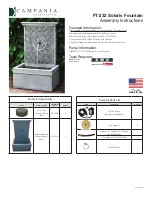
REV. 11-16-18 Page 28
Round Flat Disc Fire Pits
ADDITIONAL TROUBLE SHOOTING
Symptom
Remedy
Fire Pit
Won’t Light
1. Bleed gas line.
2. Ensure all gas lines are turned ON.
3. Ensure there is not too much media overtop the burner, it can inhibit the
gas flow. Too little or no media can also contribute to non-lighting.
4. Check alignment of thermocouple (TC) over rainshield on page 22, Fig. 23. Adjust if needed.
5. Check batteries in battery pack. Minimum total voltage to operate should be 5.3 volts.
No Spark to
Ignite
1. Visually look at ignitor for any physical damage.
2. Ensure batteries are not installed backwards in battery pack. Check min. voltage of 5.3 volts.
3. Ensure battery in transmitter is not installed backwards and at minimum voltage of 9.0 DCV.
Continues to
Spark after
Lighting
1. Thermocouple out of alignment.
2. Check connection of thermocouple at “S” terminal on control module to ensure it is connected.
Low Flame
1. Ensure the base media is at least 1 to 2-inch in diameter and top media is no more than 1-inch
over top of burner.
2. Ensure all shut-off valves and valve is fully open.
3. Check for spider webs inside burner orifice.
Water in my
Fire Pit
1. Excess dust/sand material from media may be blocking the weep holes to relieve water. Remove
all media and unplug weep holes. Clean or install new media free of dust and dirt.
2. Ensure fire pit enclosure has proper drainage for water and proper ventilation to dry out.
3. Recommend to purchase a cover/lid to keep excessive water out of the fire pit.
Whistling Noises 1. Check media to ensure it is not too tightly packed around the burner tube.
2. Ensure a non-whistling flex connector is being used.
Fire Pit Won’t
Stay Lit
1. Check alignment of thermocouple over rainshield on page 22, Fig. 23.
2. Thermocouple reading should be between 10-20mV. Test at the brass ground lead on gas valve
and the gold lead at “S” terminal on the control module. If no minimum millivolts are maintained
replace the TC.
3. Check continuity of thermocouple. Using a volt meter remove the TC test lead “S” from the
control module and the brass fork terminal from the gas valve. Test for continuity. If no continuity
then replace the TC.
4. Ensure thermocouple is clean and free of any debris. Excessive soot can be an issue.
FIRE PIT MAINTENANCE
1. The fire pit should be inspected and cleaned before initial use at least annually by a qualified field service person.
2. Any component that is found faulty must be replaced with an approved component.
3. Any tampering or modifying with the fire pit is dangerous and voids all warranties.
4. During winter months in cold climates and various seasons operation the fire pit may be affected by weather
conditions. It is recommended to use a ventilated cover overtop of your fire pit to protect it from humid/rainy weather
conditions when not in use. Heavy rains/downpours could affect the fire pit operation if not covered; if this
occurs ensure you allow the fire pit time to dry out before attempting to operate.
NOTE
: If a combustible type cover is
used over the fire pit when not in use be sure to remove it before operation to prevent a severe safety hazard.
5. Carbon (soot) may build up on the surface of logs (if installed) during heavy use. Sooting may also occur periodically
on the screen of the ignitor hood. To clean, brush off with a dry bristle brush or cloth. Keep soot away from clothing or
furniture.
6. Over time stainless steel parts can discolor when heated, usually a golden or brown hue. This discoloration is normal
and does not affect the performance of the appliance.
SECTION C THERMOCOUPLE FLAME SENSE (TFS) INST
ALLA
TION
f i r e - p a r t s . c o m











































